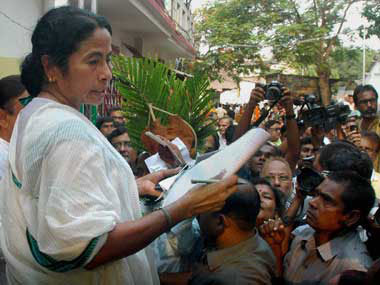by Ruchir Joshi Editor’s Note: In any countdown of dramatic political moments of 2011, we would have to include the West Bengal elections in May. Mamata Banerjee, the stormy petrel of Indian politics, fulfilled her lifelong ambition of ousting the Left Front from its citadel in West Bengal this year. Ruchir Joshi’s Poriborton! is made up of dispatches from the heady days leading up to that victory. While Mamata the politician is well-known to most of us, few outside Bengal have heard about Mamata the painter. Here is Joshi encountering the creative side of the politician. Excerpted from Poriborton! An Election Diary (Harper Collins India). Just as no candidate can get to the US presidency while admitting to atheism, or, indeed, to any other religion but Christianity, no major politician in India can actually say, ‘I hate cricket. I don’t understand it. It bores the fuck out of me.’ Across the business end of the World Cup, it becomes clear that Didi doesn’t do cricket. Through the quarters and semis and up to the final, she maintains a sphinxlike silence, except to say, ‘I support the Indian team and I wish them the best of luck.’ What I start liking about MamBan during this time is that she doesn’t suddenly develop a love for the game or pretend to watch the matches on TV. As the nation and the city do their mass nail-biting, Mamata Banerjee, Uber-Didi, supposed chief-minister-in-waiting occupies herself by Ö painting. On the day India play Australia, she completes, according to some reports, seven big canvases. Against Pakistan the fever mounts and she apparently finishes ten paintings on the day. The day after the final against Sri Lanka, nobody bothers to send in a count…  A couple of days later, I find myself looking at an exhibition of paintings at Gallerie 88 on Theatre Road. The canvases in acrylic are mostly uniform, medium sized, with a few larger works interrupting the pattern that spreads across the two small floors of the gallery. At first glance, this is the worst kind of amateur daubing, the kind of stuff done by the bored wife of a corporate executive or a high-ranking army officer, just enough knowledge to know what passes for ‘modern’ art and nothing of the heart or skill needed to make the images rise above the banal. But, as I look harder at the paintings, I start to see something else. This is actually childlike painting, there is no pretence at presenting the paintings as anything other than what they are. There are lots of flowers but some of the flower pictures are monochrome, white on white, or blue on blue, avoiding the deployment of every tube in the paintbox, which is the mark of the truly hopeless wannabe artist. Occasionally, there is even a slash or splodge of pigment that’s confident and, god help me, brings to mind various great painters. Howard Hodkin, David Hockney and even Philip Guston picked up from some turpentine ether. As I walk through the exhibition I see red dots under most of the paintings. There are no images of suffering masses, this is what Mamata Banerjee does to get away from all that, this is clearly her semi-abstract, cricket-free utopia, her only known self-indulgence besides the occasional fried street snack. Idly, I try and calculate which and how many of these canvases MamBan painted as each succeeding game bringing India closer to the World Championship shut down her campaign. On the first floor of the exhibition I see three people, two women and a man huddled around a table, sorting out postcard reproductions of the works. They look more like party workers than gallery assistants but I ask them how much the paintings are selling for. They look at me shiftily, as if I’ve accused them of something scandalous of which they are guilty. One of them points to a door. ‘Bhetorey jigyesh korun’. Please ask in there. I knock on the door and open it. There’s a man inside, bothering some files. I ask him if I can have a price list. ‘Shob sold out,’ he replies tersely, before turning back to his paperwork. As I leave, I try and remember paintings made by the young Adolf Hitler and can’t find any comparisons. Next, I try the old Winston Churchill and his watercolour landscapes, but again, nothing matches. This is a mind and an eye of a different order and, try as I might, I can’t really tell from these paintings whether the people of Bengal should be worried about a chief minister with a psycho condition or be relieved that their leader has recourse to a calming artistic hobby.
While Mamata the politician is well-known to most of us, few outside Bengal have heard about Mamata the painter. In his book ‘Poriborton! An Election Diary’, Ruchir Joshi encounters her creative side. An excerpt.
Advertisement
End of Article
Written by FP Archives
see more


)
)
)
)
)
)
)
)
)



